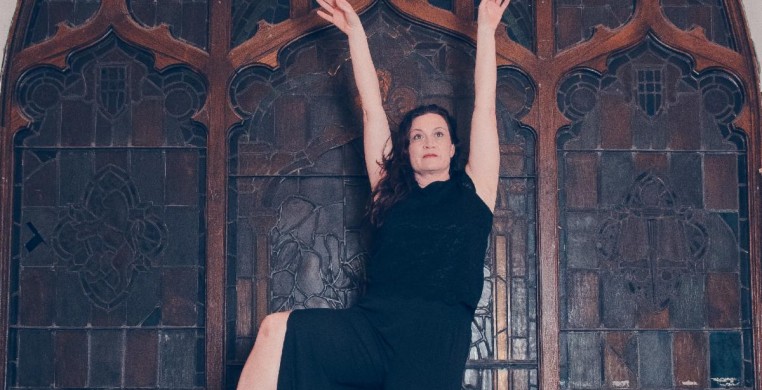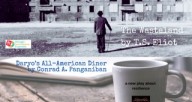Chicago Danztheatre Ensemble’s “The Wasteland”(2001) journeys along the road from enslavement to freedom, from exile to deliverance toward redemption in a metaphoric Promised Land.
The multi-week run of this newly-revised (2023) version, opened last Friday at their home base, Ebenezer Lutheran Church on Foster Avenue, and will run through May 20th.
Ellizabeth Adler’s adaptation of selected passages from T.S. Eliot’s epic poem, “The Wasteland” forms the script for a series of loosely-connected segments that focus on the journey from the hopelessness of Eliot’s post-WW I, toward a 21st-century future of hope and redemption. Mirroring the biblical journey of crossing the Red Sea, the production follows a route across a desert of despair (COVID perhaps?) toward a personalized deliverance in a “promised land,” in which love is the redemptive force. Original drawing and media by David Sorello and lighting by Joshua Paul Weckesser provide the changing landscape for that journey.
Dantztheatre dedicates itself to building community through the performance and teaching of the arts. In program notes, artistic director Ellyzabeth Adler states, “….we build community through the arts, one story, one voice, one person at a time on stage and in the classroom.”
And yet, for all its inspiring intentions, the production falls far short of the artistic and technical realization of its objectives. The ideology behind Adler’s adaptation tavels a route filled with potholes that cripple technical professionalism and artistic merit, albeit with only the best of intentions. But good intentions, however noble, are not enough.
To its credit, Danztheatre’s educational arm reaches school children in dozens of underserved Chicago neighborhoods, providing both materials and instruction that have given a voice to the hearts and minds of hundreds of needy children in grades K-12.
Evidence of their inspired and inspiring work is on display in the lobby of the Ebenezer performance space. Visual art dances on the lobby walls creating its own version of choreography, from abstract design to objective scenes and portraits, many with words woven into the design. The expressive poetry, prose and visual imagery make an emotional impact and poignance worth the price of admission.
Adler’s adaptation of "The Wasteland" relies heavily on mimicry to convey meaning through movement. But is mimicry the only choice? I would argue that Eliot’s language stands on its own as a beacon across time. Any theatrical spin-off must add something that isn’t already implicit on the page or it risks trivialization.
The question for Danztheatre is how do you walk that thin line and preserve the integrity of the source material? Danztheatre can look to the few instances where it has successfully used fundamental elements of dance composition, such as abstraction, amplification, and dynamic variation, to do just that.
The four performers—Adler as “The Storyteller,” Courtney Reid Harris, Joshua Hogan, and Peyton Hooks—are not trained professional dancers, and yet their movement vocabulary is largely the technical vernacular of ballet and modern dance. Faltering movement execution proved a distraction.
Additionally, the scripted text came across as a relentless complaint. Was this a deliberate choice or an attempt to emphasize the urgency and importance of the words? Monotony in vocal intonation dulled dramatic impact throughout much of the performance. A striking and imaginative exception to this occurred when the cast used their voices as bells.
Danztheatre came most alive in segments of physical discovery, such as when their bodies became the flames of fire around the obelisk. This was a genuine transformative moment that exemplifies how Danztheatre might unify good intentions with their genuine resources to integrate their ideas with professional standards of theatrical presentation.
Chicago Danztheatre could take a page from other local companies presenting in various off-loop venues such as The Dance Center of Columbia College Chicago, The Ruth Page Center for the Performing Arts, and the Viaduct Theater, to name a few. If Danztheatre chooses to integrate ballet technique into their artistic palette, they might consider hiring professional dancers and choreographers for the job. Alternately, they might use movement vocabulary that is more naturally and creatively suited to their bodies and abilities.
The charge to Chicago Danztheatre Ensemble is to maximize their strong assets and lofty ideals by matching them with the mandate of professionalism in all aspects of their theatrical execution.



